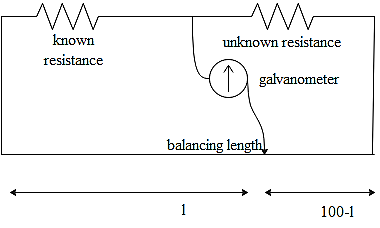
In a meter bridge experiment, the known and unknown resistances are mutually interchanged in order to remove
A. indicate error
B. end error
C. contact error
D. thermoelectric error
Answer
574.5k+ views
Hint: In a meter bridge some smaller part of the experimental wire is found to be under the metallic strip at the ends. This extra length is having a certain resistance called end resistance. Therefore, in order to calculate the accurate value of length, the balancing length is calculated by keeping the known and unknown resistances left and right gap at first. After that we are calculating the balancing length interchanging the unknown and known resistances to balance out the effect of resistance offered by terminals which is not considered.
Complete answer:
The end error or the end correction in a meter bridge is caused by a variety of reasons. If the zero mark of the scale which is attached along with the bridge wire will not start from the point where the bridge wire is leaving the copper strip and 100 cm mark of the scale also will not be at the exact position, where the bridge wire is touching the other copper strip. Another reason is that the resistances of the connecting wires and the copper strips of Meter Bridge will not be taken into notice. This end error can be avoided by the repetition of the experiment, by interchanging the known and unknown resistances from their position and the mean value of the resistances will determine the accurate measurement.
Therefore the correct answer is option B.

Note:
There are other errors also possible to occur in a meter bridge. They may be due to the heating effect sometimes. They can be because of the stray resistances used, and also error is possible because of the non-uniformly of the meter bridge wire.
Complete answer:
The end error or the end correction in a meter bridge is caused by a variety of reasons. If the zero mark of the scale which is attached along with the bridge wire will not start from the point where the bridge wire is leaving the copper strip and 100 cm mark of the scale also will not be at the exact position, where the bridge wire is touching the other copper strip. Another reason is that the resistances of the connecting wires and the copper strips of Meter Bridge will not be taken into notice. This end error can be avoided by the repetition of the experiment, by interchanging the known and unknown resistances from their position and the mean value of the resistances will determine the accurate measurement.
Therefore the correct answer is option B.

Note:
There are other errors also possible to occur in a meter bridge. They may be due to the heating effect sometimes. They can be because of the stray resistances used, and also error is possible because of the non-uniformly of the meter bridge wire.
Recently Updated Pages
Why are manures considered better than fertilizers class 11 biology CBSE

Find the coordinates of the midpoint of the line segment class 11 maths CBSE

Distinguish between static friction limiting friction class 11 physics CBSE

The Chairman of the constituent Assembly was A Jawaharlal class 11 social science CBSE

The first National Commission on Labour NCL submitted class 11 social science CBSE

Number of all subshell of n + l 7 is A 4 B 5 C 6 D class 11 chemistry CBSE

Trending doubts
What is meant by exothermic and endothermic reactions class 11 chemistry CBSE

10 examples of friction in our daily life

One Metric ton is equal to kg A 10000 B 1000 C 100 class 11 physics CBSE

1 Quintal is equal to a 110 kg b 10 kg c 100kg d 1000 class 11 physics CBSE

Difference Between Prokaryotic Cells and Eukaryotic Cells

What are Quantum numbers Explain the quantum number class 11 chemistry CBSE




